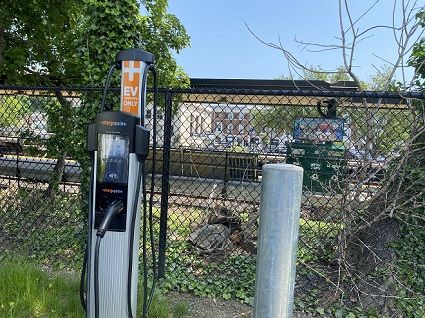From Bronxville Green Committee: The Benefits of Electric Vehicles

By Carole Upshur, Bronxville Green Committee
Jul. 1, 2020: When my Bronxville neighbor at Midland Gardens began recharging his electric car at a newly installed outlet in the garage we share, my curiosity was sparked, and not necessarily because I was stuck at home for months and eager to get on the road.
I found myself exploring recent developments in electric vehicles (EVs). I found that some people buy electric vehicles because they’re early adopters of high-tech products and some because they’re committed to the environment. But many buy electric cars for the nice finishes, safety, low maintenance, and just plain fun of driving them.
Electric vehicles accelerate quickly and handle well. They’re quiet and smooth and have no problem getting up to highway speeds or passing. Owners raved about having no repairs for over five years. Full Electric Vehicles have only 20 moving parts versus 200 for a car powered by an internal combustion engine (ICE vehicle).
Testimonials about how great Electric Vehicles are are plentiful on the web. One West Coast owner reported happily trading her $300 a month gasoline bill for a mere $15 added to her electricity bill due to the cost of operating her Electric Vehicle.
A Midwest farm family said they live twenty-two miles from town and go back and forth frequently for groceries, church, to visit friends, and for school activities. For these trips, they park their pick-up truck at home and use their Electric Vehicle.
A Bronxville resident who recently traded in his first Electric Vehicle for a second said it’s hands down the best car he’s ever owned. Some families told me they bought their first Electric Vehicle as a second car for local trips, saving their larger gas car to travel farther from home. Many of the early adopters switched entirely to Electric Vehicles once the mileage and variety of available vehicles improved.
What is an electric car?
There are several types of electric cars on the market today.
Hybrid vehicles (HEVs) have been sold for over a decade. They combine an on-board battery (or several) that allows the car to use battery power for some miles driven before a back-up gasoline engine kicks in. The Toyota Prius is an example. Hybrid vehicles don’t need to be charged, and they operate like conventional gasoline-powered vehicles, although they may be more expensive because of the added technology. The battery is charged through kinetic energy created when the driver applies the brakes. Hybrids get good gas mileage, and they reduce emissions by about 22%.
Plug-in Hybrid Electric Vehicles (PHEVs) came along more recently. Plug-ins are charged at charging stations and go farther on electric-only miles before the back-up gas engine takes over. If you’re using the car for local trips and a short commute to work for ten to fifteen miles round trip, you can avoid using gasoline altogether. Most of these vehicles get only 25-40 miles on full electric, but you don’t have to worry about recharging during longer trips. Because they use less gas and more electric power, they save about 36% on greenhouse emissions.
Battery Electric Vehicles (BEVs) are designed without any gasoline back up. Less expensive models have a 125-150 mile range, and if you spend more or select an upgraded model, you can get over 250 miles per charge.
What about charging in general and charging in Bronxville?
Many sources confirm that most people drive at least one family car no more than 30 miles a day, making a practical plug-in electric vehicle a highly practical second car. Most current owners charge at home or work.
There are different types of chargers, and if you don’t use the car much in the evening, you can plug it into a regular 120-volt plug overnight for a full charge by morning. This is a Level 1 charger (8-12 hours). Faster Level 2 or 3 chargers provide a full charge in 4-6 hours (Level 2) or in as little as one hour (Level 3).
All Electric Vehicles can use Level 2 chargers, which are the most common public chargers, but some may not be able to use the superfast Level 3 chargers that utilize direct current. Tesla has its own network of fast chargers for its cars, but they can also use the public stations.
A federal tax credit will reimburse you for one-third of the cost, up to $1,000, for installing a charging station at home. ConEd offers a special low electricity rate for overnight charging in New York areas they serve, including Bronxville.
Accessing chargers in apartment complexes can be challenging, but buildings are starting to install them. Any resident of VillaBXV can get a charger but must pay for installation. Shareholders at Midland Gardens can request them in reserved garage spaces. They share the cost of installation and pay a flat monthly fee for electricity. Rebates are available for multiunit buildings (as well as other public and private entities) through the New York State Energy Research and Development Authority (NYSERDA) that cover much of the cost of installing Level 2 charging stations. Click here to learn more.
According to NYSERDA, there are almost 5,000 charging stations in New York State, including some high-speed chargers along the New York State Thruway. As an incentive, many are free. A Westchester County bond issue passed in May 2020 provides $1 million to install additional charging stations throughout the county.
There are currently fewer high-speed chargers. Most public ones are Level 2. Most Electric Vehicles will need to plug in for only 30 minutes to get up to 80% power.
A two-car charging kiosk is located at the Bronxville train station (in the Parkway Road parking lot behind Chase Bank). Four public charging stations are being installed in the Kensington Road garage, and seventeen stations are available at the Ridge Hill Shopping Center in two different garages.
Special phone apps, such as the Plugshare app, indicate locations and the type of charger. Some owners have reported that many public chargers aren’t well maintained and don’t work, which can complicate taking Electric Vehicles on long drives. In some communities, Electric Vehicle owners offer their own home outlets for those looking to recharge and find it a great way to meet other Electric Vehicle enthusiasts.
Cold weather can shorten the range of Electric Vehicles. Many websites offer suggestions on how to drive them efficiently in snow and cold.
What about the cost?
There are more than two dozen Electric Vehicles on the market today, including basic sedans, SUVs, and luxury models. This website reviews types of EVs. If you are ready to explore, click here.
While the least expensive (starting around $30,000) generally cost more than an average sedan, rebates and tax credits can lower the cost to about the same as a compact car, especially when you factor in much lower expenses for maintenance and fuel. A federal tax credit can off-set $2,500-7,500, depending on the vehicle, although for some more popular cars, these rebates are phasing out.
Sustainable Westchester has an arrangement with a local Nissan dealer for an additional $5,000 discount on a new Nissan Leaf. New York State offers a point-of-sale rebate of up to $2,000 for Electric Vehicles (see NYSERDA.ny.gov/All-Programs). A Port Authority Green Pass from EZPass discounts tolls and allows HOV lane use for any Electric Vehicle or hybrid vehicle that gets at least 45 miles/gallon. Click here for more information on calculating the cost and savings of buying an EV:
Another option is buying a used Electric Vehicle that is being turned in from a lease. Although such purchases aren’t eligible for rebates, the initial cost is often much lower. And don’t worry about the batteries. They’re designed to last at least 100,000 miles and to be recyclable and replaceable.
Why is an electric car better for the environment?
According to the U.S. Environmental Protection Agency (EPA), in 2018, transportation contributed 28% of greenhouse gas emissions in this country. About half of that came from cars and vans while the rest was from trucks, shipping, and air travel. Substantially curbing emissions from cars will be essential if we are to meet New York State’s ambitious climate goals.
Environmental organizations frequently talk about “electrifying the grid.” Because we already have the technology to generate electricity from clean, renewable sources such as wind, solar, and hydroelectric, it makes sense to move to electricity as the major source of energy for heating and cooling our homes and businesses, and for transportation. A fully electric vehicle running on power generated by solar or wind emits zero emissions.
Although we’re in the process of switching to renewable sources, we’re far from achieving a clean electrical grid. Even so, Electric Vehicles are better for the environment. Even a car operating on electricity generated by “dirty” coal runs more cleanly than a gasoline-powered vehicle, which is inherently inefficient.
Cleaner electrical generation, such as from natural gas, increases the benefit. For example, if the electricity is from clean, renewable sources such as solar panels, there are no emissions associated with either charging or using the vehicle.
The Union of Concerned Scientists says that about 80% of the U.S. has enough of a mix of cleaner electric generation to make Electric Vehicles preferred over gasoline-powered vehicles.
Of course, it also takes raw materials and energy to produce the batteries for Electric Vehicles. Ongoing studies in the European Union suggest that the life-cycle of electric vehicles, including manufacturing, is still positive in reducing greenhouse emissions compared to gasoline-powered vehicles. The studies suggest Electric Vehicles produce 25-75% less in greenhouse emissions depending on the energy source. Further research is underway about the environmental impact of EV batteries.
We want to make sure they really can be recycled and reused cost-effectively, so as not to create a new source of hard-to-dispose-of waste. And producing the batteries requires raw materials that are mined in various places around the world at a high environmental cost.
Where can you learn more?
In addition to the links provided throughout this article, Edmunds.com, the car trade publication, reviews dozens of Electric Vehicles currently on the market, with brands like Audi, BMW, Chevrolet, Chrysler, Honda, Hyundai, Fiat, Jaguar, Kia, Nissan, Subaru, Tesla, Toyota, Volvo, and Volkswagen.
Local non-profits and New York State promote electric vehicles, in addition to NYSERDA. Also, check out Sustainable Westchester for info about rebates and other incentives.
Maybe you plan to investigate electric models when it’s time to buy your next car. For me, an EV is sounding better than ever.
You can find more information about the Bronxville Green Commitee on the Village of Bronxville website. Click here.
Pictured: Electric Vehicle Charging Station in Bronxville
Photo courtesy Bronxville Green Committee
Editor's note: As a public service, MyhometownBronxville publishes articles from local institutions, officeholders, and individuals. MyhometownBronxville does not fact-check statements therein, and any opinions expressed do not n
Sustainable Living Directory
The Bronxville Green Committee is a volunteer organization under Village government. We work with the Trustees and Village staff on programs that promote clean energy initiatives and sustainable ways of living. Our programs include The Bronxville Giving Garden, a community garden whose produce is donated to local groups; Take Back Day, when we collect items to be recycled; and Pollinator Pathways, which encourages adding native plants to our gardens. We believe everyone can make a difference by adopting simple, sustainable practices in daily life so we can work together to protect what we love -- our families, our homes and our town.












